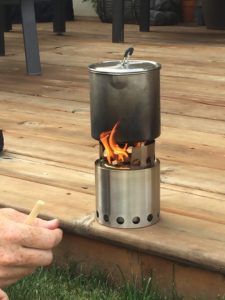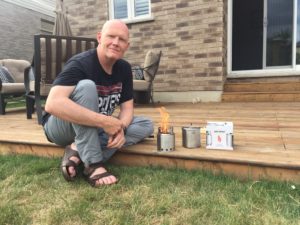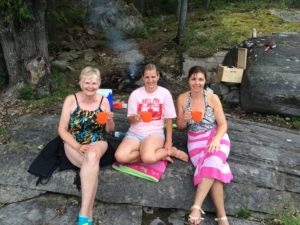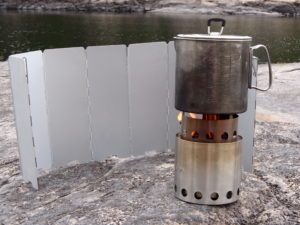 I love a good cup of coffee, particularly when I’m off on a fishing adventure. When looking at my essential gear list, ensuring that I have what’s necessary to have hot coffee is as important as my safety gear. Whether you are flying into a remote outpost camp, or a more traditional lodge, you usually have what you need in the cabin, but what about all those hours in the great outdoors?
I love a good cup of coffee, particularly when I’m off on a fishing adventure. When looking at my essential gear list, ensuring that I have what’s necessary to have hot coffee is as important as my safety gear. Whether you are flying into a remote outpost camp, or a more traditional lodge, you usually have what you need in the cabin, but what about all those hours in the great outdoors?
Speaking of the great outdoors, I love shore lunches; in fact, they are often the highlight of my trips – something I plan for in detail, and that I anticipate greatly.
 While shore lunches are usually held on the best weather days, in the spring and the fall the weather can be cool, and if you’ve had a cloudy or rainy day, what would be a better post-shore lunch pick-me-up than a cup of hot coffee (or tea)? I had been in search of a portable stove that would help me make a coffee in the wild (or a meal if need be) for a while, but I didn’t want to have to worry about packing canister or liquid fuel, and it needed to be compact enough that I could almost forget it was even there. Enter the Solo Stove Lite, a biomass burning stove that is super compact, easy to use, and incredibly efficient.
While shore lunches are usually held on the best weather days, in the spring and the fall the weather can be cool, and if you’ve had a cloudy or rainy day, what would be a better post-shore lunch pick-me-up than a cup of hot coffee (or tea)? I had been in search of a portable stove that would help me make a coffee in the wild (or a meal if need be) for a while, but I didn’t want to have to worry about packing canister or liquid fuel, and it needed to be compact enough that I could almost forget it was even there. Enter the Solo Stove Lite, a biomass burning stove that is super compact, easy to use, and incredibly efficient.
 I first started looking at the Solo Stove line up (and other competitors) researching what back packers and campers used when they were in the bush. As a person who does fly-in fishing trips, I face the same weight and packing restrictions so there seemed to be similarities. I do think that these brands may want to consider the angler as a viable market, but I may be biased. I envisioned using a bush stove for two main reasons: first, for a hot cup of coffee to cap off a shore lunch; second, to make a meal, either through using boiled water in a dehydrated meal pack, or even to cook a simple meal. I decided on the Solo Stove for a couple reasons. First, the reviews were very favourable, and second, I like that I could purchase the accompanying pot (the 900) and they would pack together. I’ve watched many “how to videos” and thought I should do some practice before trying it in the bush. Below is a video I did which is both an unboxing and a “first try”. This video is about 4 minutes long, and further down in the post I have a shorter one that demonstrates me using the stove in the field. I think it’s important to note that I purchased this stove, pot and screen myself.
I first started looking at the Solo Stove line up (and other competitors) researching what back packers and campers used when they were in the bush. As a person who does fly-in fishing trips, I face the same weight and packing restrictions so there seemed to be similarities. I do think that these brands may want to consider the angler as a viable market, but I may be biased. I envisioned using a bush stove for two main reasons: first, for a hot cup of coffee to cap off a shore lunch; second, to make a meal, either through using boiled water in a dehydrated meal pack, or even to cook a simple meal. I decided on the Solo Stove for a couple reasons. First, the reviews were very favourable, and second, I like that I could purchase the accompanying pot (the 900) and they would pack together. I’ve watched many “how to videos” and thought I should do some practice before trying it in the bush. Below is a video I did which is both an unboxing and a “first try”. This video is about 4 minutes long, and further down in the post I have a shorter one that demonstrates me using the stove in the field. I think it’s important to note that I purchased this stove, pot and screen myself.
I actually used the stove again later that day (the day I shot that video) to cook some Kraft Dinner for the kids, because I was just amazed by the efficiency and ease of use. I used a much larger camp pot for the Kraft Dinner, and I also switched to using wood pellets to compare the sustainability of the flame. The wood pellets took much longer to catch, particularly since you lite them on the top, but once it got going I confess it was nice to not have to continually feed the fire, because it was ravenous. As an added bonus, we cooked some smores after, as we still had plenty of hot coals.
 My first chance to use the Solo Stove in the field was on a recent trip to the French River on a”couples trip”. Pictured here are the ladies, enjoying a nice cup of hot tea following our shore lunch. After we were done eating, I fired up the Solo Stove and started some water boiling as the girls had a dip, and the guys started the clean up / pack up. There were six of us, and the orders came in for 3 cups of tea, and two coffee. With a 30 oz pot, the 900 made enough for 4 with room to spare, and it was quick to heat up the extra. For coffee I use these Starbucks Instant packs, which are dynamite.
My first chance to use the Solo Stove in the field was on a recent trip to the French River on a”couples trip”. Pictured here are the ladies, enjoying a nice cup of hot tea following our shore lunch. After we were done eating, I fired up the Solo Stove and started some water boiling as the girls had a dip, and the guys started the clean up / pack up. There were six of us, and the orders came in for 3 cups of tea, and two coffee. With a 30 oz pot, the 900 made enough for 4 with room to spare, and it was quick to heat up the extra. For coffee I use these Starbucks Instant packs, which are dynamite.
There was a bit of a breeze in the air, so I brought out the optional wind screen to help keep the flames steady. The wind screen is great in that it’s light, compact and comes with it’s own canvass bag, so there is no issue adding it to the gear.

The one flaw I found with the screen was that it doesn’t work quite as well on rock. It has a couple pins that you can use to push into the earth to stabilize it, but they won’t get through Canadian Shield. Also the screen is rigid by design, so on uneven ground it is harder to get it stable. Still, for the small effort, the results were worth it.
As a side benefit, I was able to use the same flame to heat up some water to use in the portable camp sink to wash up. The warm water was a real treat, and made the clean up nice and easy. Check out this next video where I walk through fire-starting to pouring!
If you camp, hike, or, as in my case, fish, I’d give some real thought to checking out the Solo Stove. It was easy to use, compact, and I was able to use wood from the ground when I wanted. No need to carry fuel so it is safe to take on planes too! Learn more from the Solo Stove Site.
Don’t forget, to stay in touch simply sign up and have my most recent post sent right to you!